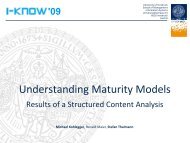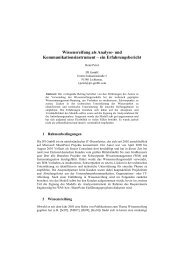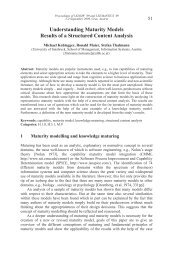MATURE Deliverable 1. - Knowledge Maturing
MATURE Deliverable 1. - Knowledge Maturing
MATURE Deliverable 1. - Knowledge Maturing
You also want an ePaper? Increase the reach of your titles
YUMPU automatically turns print PDFs into web optimized ePapers that Google loves.
stable. Changes during development of the first draft of codes demanded a rescan and recoding of the<br />
considered data material. Preliminary codes were applied to the entire set of field data during recoding.<br />
Thus, it was necessary to change some assignments in order to achieve homogeneous assignment of all<br />
codes. During this phase, the number of codes increased over time.<br />
Fluctuating phase:<br />
Again, relevant codes were identified and revised. The number of codes increased significantly and there<br />
was relatively high fluctuation within the codes. The phase was also characterized by consolidation of<br />
codes and thus the number of codes decreased. At the end of this phase, approximately 2/3 of the material<br />
was scanned and again recoding was necessary.<br />
Stabilization phase:<br />
Finally, the remaining 1/3 of field data was investigated. Thereby, no significant changes in the codes<br />
occurred. Definitions of criteria turned out as suitable and applicable in this phase. Changes to the codes<br />
were mainly caused by merging codes or revising or refining code descriptions. A complete rescan was<br />
necessary in order to ensure consistent understanding of all code assignments throughout the entire set of<br />
field data. The stabilization phase was considered to be finished as soon as the final codes appeared to be<br />
stable and as soon as all identified characteristics could be represented by the final codes.<br />
start with<br />
initial codes<br />
growth<br />
Figure 3: Coding procedure<br />
162 final codes from UIBK were presented at the ethnographers meeting that took place in Frankfurt on<br />
September 26. All other ethnographers were welcomed to use the comprehensive list of codes as initial<br />
codes when starting their own coding procedure. Each team of ethnographers then went through a similar<br />
coding procedure in parallel. This means that some of the 162 initial codes were reused whereas others<br />
were added to the list of initial codes. The overlap with the initial codes and with other partners’ codes is<br />
depictured in Figure 4.<br />
20<br />
consolidation<br />
[Dey, 1993]<br />
end with individually<br />
final codes







